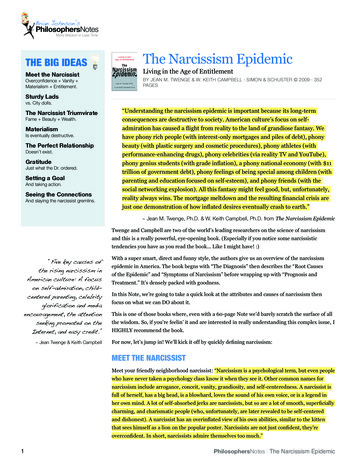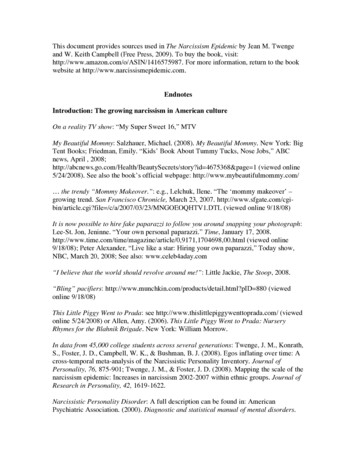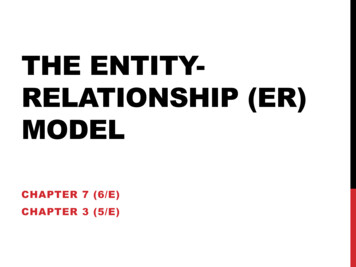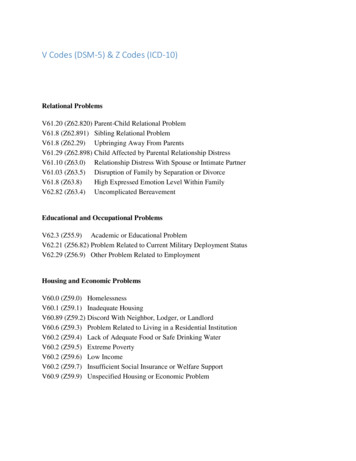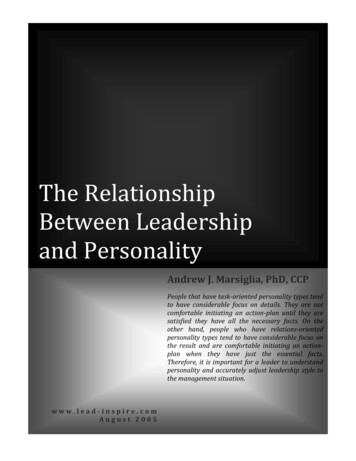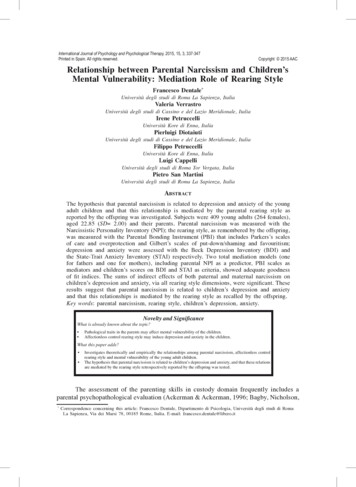
Transcription
International Journal of Psychology and Psychological Therapy, 2015, 15, 3, 337-347Printed in Spain. All rights reserved.Copyright 2015 AACRelationship between Parental Narcissism and Children’sMental Vulnerability: Mediation Role of Rearing StyleFrancesco Dentale*Università degli studi di Roma La Sapienza, ItaliaValeria VerrastroUniversità degli studi di Cassino e del Lazio Meridionale, ItaliaIrene PetruccelliUniversità Kore di Enna, ItaliaPierluigi DiotaiutiUniversità degli studi di Cassino e del Lazio Meridionale, ItaliaFilippo PetruccelliUniversità Kore di Enna, ItaliaLuigi CappelliUniversità degli studi di Roma Tor Vergata, ItaliaPietro San MartiniUniversità degli studi di Roma La Sapienza, ItaliaAbstrActThe hypothesis that parental narcissism is related to depression and anxiety of the youngadult children and that this relationship is mediated by the parental rearing style asreported by the offspring was investigated. Subjects were 409 young adults (264 females),aged 22.85 (SD 2.00) and their parents. Parental narcissism was measured with theNarcissistic Personality Inventory (NPI); the rearing style, as remembered by the offspring,was measured with the Parental Bonding Instrument (PBI) that includes Parkers’s scalesof care and overprotection and Gilbert’s scales of put-down/shaming and favouritism;depression and anxiety were assessed with the Beck Depression Inventory (BDI) andthe State-Trait Anxiety Inventory (STAI) respectively. Two total mediation models (onefor fathers and one for mothers), including parental NPI as a predictor, PBI scales asmediators and children’s scores on BDI and STAI as criteria, showed adequate goodnessof fit indices. The sums of indirect effects of both paternal and maternal narcissism onchildren’s depression and anxiety, via all rearing style dimensions, were significant. Theseresults suggest that parental narcissism is related to children’s depression and anxietyand that this relationships is mediated by the rearing style as recalled by the offspring.Key words: parental narcissism, rearing style, children’s depression, anxiety.Novelty and SignificanceWhat is already known about the topic? Pathological traits in the parents may affect mental vulnerability of the children.Affectionless control rearing style may induce depression and anxiety in the children.What this paper adds? Investigates theoretically and empirically the relationships among parental narcissism, affectionless controlrearing style and mental vulnerability of the young adult children.The hypothesis that parental narcissism is related to children’s depression and anxiety, and that these relationsare mediated by the rearing style retrospectively reported by the offspring was tested.The assessment of the parenting skills in custody domain frequently includes aparental psychopathological evaluation (Ackerman & Ackerman, 1996; Bagby, Nicholson,*Correspondence concerning this article: Francesco Dentale, Dipartimento di Psicologia, Università degli studi di RomaLa Sapienza, Via dei Marsi 78, 00185 Rome, Italia. E-mail: francesco.dentale@libero.it
338Dentale, Verrastro, Petruccelli, Diotaiuti, Petruccelli, caPPelli, & san MartiniBuis, Radovanic, & Fidler, 1999; Lempel, 1999), based on the assumption that pathologicalpersonality traits of the parents may influence the quality of their rearing behaviorsand as a consequence of the children’s mental health. As evidence of this theoreticalmediation model connecting parental pathological traits (PPT) with their children’s mentalhealth via the quality of rearing behaviours, many studies (see Laulik, Chou, Browne, &Allamb, 2013 for a systematic review) showed that PPT are correlated with the qualityof parent-child interactions and rearing practices such as inconsistent parental discipline,low parental affection, assistance and encouragement, insensitive or intrusive interactionswith the children, harsh or disoriented parental behavior. In particular, of eleven studiesselected and examined by the authors, nine confirmed the positive correlation betweenparental Personality Disorders (PD) traits and impaired rearing behaviors even whenthe effects where controlled for relevant confounding factors. Moreover, importantly,several studies showed that PD traits in the parents were found to be related to specificpsychiatric conditions in the children (see Dutton, Denny-Keys, & Sells, 2011 for areview). For instance Calvo, Lazaro, Castro, Morer, & Toro (2007) showed that inparents of children with Obsessive Compulsive Disorder there were higher scores onPD traits if compared with control parents, and similarly Nordahl, Ingul, Nordvik, &Wells (2007) found a significant relationship between PD traits in the mothers (i.e.interpersonal difficulties with a self-centered style) and Generalized Anxiety Disorderand Oppositional Defiant Disorder prevalence in the children.Referring to specific PDs, Laulik et al. (2013) found that parental cluster Bdisorders and in particular Borderline Personality traits exerted a negative effect onparenting in eight of the studies examined. Surprisingly, in spite of the clinical and legalinterest toward the effect of parental narcissism on rearing behaviours and children’smental health (e.g. Rappoport, 2005; Brown, 2008), only few empirical studies wereconducted to investigate these hypotheses systematically.The scientific concept of narcissism has been variously defined by differentrelevant authors in a psychodynamic theoretical framework (Freud, 1914; Kohut, 1971;Kernberg, 1975). They have clarified the main characteristics of narcissistic personalityas well as its relations to normal and abnormal personality development.According to Freud, some individuals develop an ego characterized as a sexualloaded object, acquiring in this manner a narcissistic personality with a natural tendency tobe dominant and to influence the others. Successively, in order to improve their theoreticalmodels for the treatment of borderline personality disorders, Kernberg (1975) and Kohut(1971) proposed, as main characteristics of narcissism, not only sense of superiority,grandiosity, self-absorption, exhibitionism, arrogance and feelings of entitlement butalso fragile self-esteem and emotional instability. Importantly, on a theoretical point ofview narcissistic personality characteristics are generally considered as relatively stableover time (e.g. Kernberg, 1975) and, recently, some longitudinal studies (Samuel et al.,2011; Vater et al., 2014) found moderate to high levels of test-retest correlations acrossa temporal interval of two years, confirming the stability hypothesized.More recently, a large discussion has developed in the literature (see Pincus &Lukowitsky, 2010 for a review) aimed at clarifying the nature of normal and pathologicalnarcissism. The former has been generally characterized by a series of defensive InternatIonal Journal of Psychology & PsychologIcal theraPy, 2015 15, 3http://www. ijpsy. com
Parental narcissisM chilDren’s Mental VulnerabilityanDrearing style339strategies, that permit to enhance one’s self-image and self-esteem. As such strategiesare largely used by healthy individuals, it did not seem appropriate to consider them asabnormal aspects of personality. Differently, pathological narcissism has been viewedas composed of two complementary aspects, grandiosity -as reflected for instance inexaggerated self-esteem and exhibitionism-, and vulnerability, characterized by fragileself-esteem and emotional instability. Interestingly, Miller and Campbell (2008) showedthat personality profiles of normal and pathological narcissistic individuals, althoughdiffering in extraversion and neuroticism (i.e. high extraversion and low neuroticismin the formers vs. low extraversion and high neuroticism in the latters), shared anantagonistic interpersonal style that included (1) a strong need for power and controlof the others and (2) a certain lack of empathy toward other people.Regarding parental narcissistic traits, several clinicians, on the basis of theirclinical experience (Fraiberg, 1980; Espasa, 2004), have suggested that narcissisticparents are likely to present a tendency to deny the needs of their children and to usethem as “props” for their own self-esteem, thus assigning them a complementary role.For instance, Espasa (2004) argued that insufficiently elaborated narcissistic needs maybe recalled and renewed when individuals become parents, bringing their children toadapt themselves to this projective parental scenario. If these projective identificationsare severe and inflexible, parents may become unable to empathize with the real needsof their children, and this may result in distressing familiar conditions that prepare theground for the development of different forms of psychopathology in the offspring. Forinstance, recently Rappoport (2005), in order to illustrate the accommodation strategiesof narcissistic parents’ children, introduces the term “co-narcissism”. The author focusedon narcissistic parents with a very low self-esteem, interpersonally rigid, easily offended,self-absorbed, blaming, not empathic with others and who attempt to control others’views of them for defensive purposes. Co-narcissistic children, attempting to preservetheir relationship with parents, tend to please them, defer their points of view andwould be often depressed or anxious as they may easily considered selfish if they actassertively. Interestingly as reported by Horne (1998), parental narcissism was found to benegatively correlated with self-esteem of the offspring, suggesting that, as hypothesizedby Rappoport (2005), children of narcissistic parents tend to please the parents’ needsin order to avoid relational conflicts and preserve the attachment relationship.Parental narcissism may be seen therefore as a factor that may undermine thequality of the rearing style. More specifically, the rearing style of narcissistic peopleseems to be in line with the dysfunctional pattern of affectionless control (e.g., Parker,1979), characterized by excessive control (overprotection) and lack of empathy (low care).In the attachment theory framework (e.g., Bowlby, 1977), it is generally arguedthat parents, not able to be a secure base for their children, induce the developmentof an insecure attachment, making them more prone to psychopathology. In orderto investigate the relationship between parental rearing style and psychopathologicalvulnerability of the children, several instruments have been developed based on thememories of the offspring, such as the Children’s Reports of Parental Behavior Inventory(CRPBI; Schaefer, 1965), the Egna Minnen Betraeffande Unde Uppfostran (“My growthmemories”; EMBU, Perris, Jacobson, Lindstrom, Van Knorring, & Perris, 1980), andhttp://www. ijpsy. com InternatIonal JournalofPsychology & PsychologIcal theraPy, 2015, 15, 3
340Dentale, Verrastro, Petruccelli, Diotaiuti, Petruccelli, caPPelli, & san Martinithe Parental Bonding Instrument (PBI; Parker, Tupling, & Brown, 1979; Parker, 1989;Cappelli, & San Martini, 2004, for the Italian version). Importantly some reviews (e.g.Brewin, Andrews, & Gotlib, 1993) showed that the scales based on retrospective reportsof parental behavior generally revealed an adequate level of reliability and validity.Moreover, the use of these questionnaires appear to be more simple in respect to othermethods (e.g. interview) that implies a training for the judges and/or the assessmentof their agreement.According to Parker (1979), the rearing pattern of affectionless control, definedin terms of low care and overprotection, is a factor of psychopathological risk forthe offspring. In order to measure this style, he devised the PBI (Parker, Tupling, &Brown, 1979; Parker, 1979), that evaluates the parental rearing style as recalled by thechildren. This instrument has been widely used in studies that have generally confirmedParker’s claim of a psychopathological potential of affectionless control, particularlywith reference to the risk of depression and anxiety in the children (e.g. Safford, Alloy,& Pieracci, 2007; Gladstone & Parker, 2005). More recently Gilbert, Allan, and Goss(1996) broadened the pattern of affectionless control, including in the assessment of theparental style the tendency to debase and humiliate the child (putdown-shaming) and thetendency to favour brothers or sisters to the detriment of the subject (favouritism). Theformer tendency may be ascribed to an antagonistic interpersonal style that, as alreadymentioned, typically characterizes both normal and pathological narcissism. The cognitivesalience of antagonistic scenarios may explain also the tendency to favour the one orthe other of the children, bringing the parents to transfer their narcissistic/competitiveinterpersonal scripts onto the children and to ignore their natural need for approval.This study explores the relations between parental narcissism, affectionless controlstyle (as retrospectively reported by the offspring) and the psychological vulnerabilityof the young adult children. Specifically, our expectations are that, in a non clinicalsample, parental narcissism is related to children’s depression and anxiety, and thatthis relations are mediated by the rearing style retrospectively reported by the offspring(Parker, Tupling, & Brown, 1979; Parker, 1979; Gilbert, Allan, & Goss, 1996).MethodParticipants and ProcedureSix hundred young adults were administered with the paternal and maternalforms of the PBI, along with the BDI and the STAI. They were also invited to asktheir parents to fill in the NPI if they agreed to do so. Both biological parents of 409respondents (264 females and 145 males; aged 22.85, SD 2.00) agreed to participate.Only one adult child for each family was involved as participant. The mean age ofmothers was 50.37 (SD 5.14) and that of fathers was 54.10 (SD 5.56). Mothers wereprevalently housewives (28.6%), workers (13.9%), clerks (9.3%) and teachers (5.4%)while fathers were prevalently workers (21.3%), clerks (14.2%), retired persons (8.1%)and entrepreneurs (4.6%). InternatIonal Journal of Psychology & PsychologIcal theraPy, 2015 15, 3http://www. ijpsy. com
Parental narcissisM chilDren’s Mental VulnerabilityanDrearing style341Measures- Narcissistic Personality Inventory (NPI; Raskin & Terry, 1988; Montebarocci, 2002 forthe Italian version). The NPI is generally conceived as a measure of normal (Pincus &Lukowitsky, 2010; Miller & Campbell, 2008), but for some aspects also of pathological narcissism (Ackerman, Witt, Donnellan, Trzesniewski, Robins, & Kashy, 2011).It is composed of 40 items consisting of two opposite statments (e.g., “I think I ama special person” vs. “I am no better or worse than most people”). Participants areforced to choose the alternative that best matches with him/her. The Italian versionshowed a Cronbach’s alpha of .83. In accordance with the studies mentioned above onthe temporal coherence of narcissistic personality characteristics (Samuel et al., 2011;Vater et al. 2014), NPI scores showed a high level of test-retest correlation over time(Del Rosario & White, 2005), suggesting that also parents involved in the presentresearch may show a similar stability, especially in adult age.- State-Trait Anxiety Inventory Y Form (STAI, Y Form; Spielberger, Gorsuch, Lushene,Vagg, & Jacobs, 1983; Pedrabissi & Santinello, 1989 for Italian version). Anxiety wasassessed with the trait scale of the STAI-Y form, an inventory containing 20 itemsthat assess symptoms of anxiety on a 4-point Likert scale (1 almost never, 4 almostalways). The Italian version presented alphas .85 in both adult and adolescent samples.- Parental Bonding Instrument enlarged version (PBI; Parker, Tupling, & Brown, 1979;Parker, 1979; Gilbert, Allan, & Goss, 1996; Cappelli & San Martini, 2004 for Italianversion). The parental rearing style was measured by an enlarged version of the PBI,containing, the original scales of care and overprotection, and also Gilbert’s scales(Gilbert et al., 1996) of putdown/shaming and favouritism. For each item the respondent was requested, with a 5 point-likert scale, to assess the parental behaviour duringthe his/her first sixteen years of life. Two forms are available for each scale, one forfathers and the other for mothers. All these scales, in the Italian version, showed goodinternal consistencies, with alphas ranging from .87 to .93.Data analysesTo test the mediating model hypothesized, two path analyses (one for the fathersand one for the mothers) were conducted, with parental narcissism as a predictor, PBIscales as mediators, and depression and anxiety as criteria, using M-plus statisticalpackage (Muthén & Muthén, 2007). A preliminary evaluation of partial mediationmodels did not show any significant improvement in terms of fit indices with respectto the total mediation model. Moreover, the direct effects estimated between parentalnarcissism and children’s vulnerability criteria (i.e. depression and anxiety scores) werenot significant. As a consequence these models were discarded following the scientificcriterion of parsimony and only total mediation models were considered. For the pathcoefficients a maximum likelihood estimation method was used and 95% bias-correctedconfidence intervals were calculated for all effects with a bootstrap procedure (Preacher& Hayes, 2008).http://www. ijpsy. com InternatIonal JournalofPsychology & PsychologIcal theraPy, 2015, 15, 3
342Dentale, Verrastro, Petruccelli, Diotaiuti, Petruccelli, caPPelli, & san MartiniresultsKurtosis and asymmetry parameters showed values close to zero and thuscompatible with an approximately normal distribution. As expected both paternal andmaternal narcissism were negatively correlated with care and positively with all otherparental rearing scales (as evaluated by the children), with correlations ranging fromsmall to medium in terms of Cohen’s standards (see Table 1). Moreover, they showedsmall but significant positive correlations with the scores of depression and anxiety ofthe children. PBI scales were all highly inter-correlated, and as expected, moderatelycorrelated with depression and anxiety of the children in the expected direction.Overall, this pattern of correlations appears to be consistent with the mediation modelhypothesized (Figures 1 and 2).Table 1. Correlations below the main diagonal are among paternal scales and those above the maindiagonal are among maternal scales.Narcissism Care Overprotection PD-S Favouritism Depression 31.31.35.58-Notes: All correlations are significant at the .01 level (2-tailed); PD-S putdown/shamingFigure 1. Path diagram of the mediating model hypothesized that illustrates all direct effectsestimated among paternal narcissism, paternal rearing dimensions and children depressionand anxiety. InternatIonal Journal of Psychology & PsychologIcal theraPy, 2015 15, 3http://www. ijpsy. com
Parental narcissisM chilDren’s Mental VulnerabilityanDrearing style343Figure 2. Path diagram of the mediating model hypothesized that illustrates all direct effectsestimated among maternal narcissism, maternal rearing dimensions and children depression and anxiety.As illustrated in Figure 1, a total mediation model including paternal narcissismas predictor, paternal PBI scales as mediators and children’s depression and anxietyas criteria was tested. As stated before, partial mediation models were preliminarilyevaluated and discarded, as no improvements in terms of fit indices was found withrespect to the total mediation model and no significant direct effects emerged betweenpaternal narcissism and children’s depression and anxiety.The model showed an excellent fit, with a non-significant chi-square [χ2 (2 df) .97, p .61] and adequate levels for other relevant fit indices (CFI 1; TLI 1.012;RMSEA .00, CI .00-.08; SRMR .01), suggesting that the rearing style fully mediatedthe effect of paternal narcissism on the scores of depression and anxiety. Overall, themodel accounted for 16% of depression and for 17% of anxiety variance. All individualdirect effects (see Figure 1), between paternal narcissism and PBI as well as betweenPBI and depression and anxiety, were significant (or close to significant) and in theexpected direction, except for putdown/shaming that did not show direct effects ondepression and anxiety.The total indirect effect of paternal narcissism (via all PBI scales) was significantboth on depression (standardized sum of indirect effects .13, p .001; CI .06-.20) andon anxiety (standardized sum of indirect effects .13, p .001; CI .06 -.20). With theexception of the indirect effect via putdown/shaming that did not contribute uniquely tothe mediation model, individual indirect effects of paternal narcissism were all significant(or close to significant) for both children’s depression and anxiety, with standardizedvalues ranging from .02 to .07A similar total mediation model was tested for the maternal scales (see Figure 2)as, also in this case, a preliminary analysis of partial mediation models did not show anyhttp://www. ijpsy. com InternatIonal JournalofPsychology & PsychologIcal theraPy, 2015, 15, 3
344Dentale, Verrastro, Petruccelli, Diotaiuti, Petruccelli, caPPelli, & san Martiniimprovement in terms of fit indices and no significant direct effects emerged betweenpaternal narcissism and children’s depression and anxiety.Again the total mediation model revealed an excellent fit, with a non-significantchi-square [χ2 (2 df) .40, p .82] and adequate levels of the other relevant fit indices(CFI 1; TLI 1.019; RMSEA .00, CI .00-.06; SRMR .01). Overall the modelaccounted for 21% of depression and for 17% of anxiety variance. All individual directeffects (see Figure 2), between maternal narcissism and PBI as well as between PBIand depression and anxiety, were significant (or close to significant) and in the expecteddirection, except for care that did not show any direct effects on both depressionand anxiety. The total indirect effect of maternal narcissism (via rearing scales) wassignificant both on depression (standardized sum of indirect effects .14, p .001; CI .07 -.22) and on anxiety (standardized sum of indirect effects .13, p .001; CI .06-.21). Individual indirect effects of maternal narcissism were all significant (or closeto significant) for both depression and anxiety, ranging from .03 to .05 (standardizedvalues), except for the indirect effect via the care scale that did not offer any uniqueindirect contribution to the model.discussionAs illustrated in the results section, total mediation models, including parentalnarcissism as predictor, PBI scales as mediators and children’s depression and anxietyas criteria, showed a good fit both for fathers and for mothers, while partial mediationmodels were discarded based on preliminary analyses that did not show any improvementin the fit indices for them and any significant direct effect between parental narcissismand children vulnerability criteria (i.e., depression and anxiety). Both paternal andmaternal narcissism are significantly correlated with parental rearing dimensions as wellas with depression and anxiety of the young adult children in the expected direction.At the same time, PBI scales and children’s depression and anxiety were significantlycorrelated with the expected pattern. Importantly, paternal and maternal path analysesshowed that the effect of parental narcissism was mediated by the parental rearing stylewith significant sum an indirect effects both on depression and anxiety. These results arecompatible with a generally assumed mediation model, mentioned in the introduction(Laulik, Chou, Browne, & Allamb, 2013 for a review), that posits parental pathologicaltraits, quality of parenting behaviours and children’s mental health indices as predictors,mediators and criteria respectively.A relevant limitation of the present study is the use of retrospective measures ofthe parental rearing style as reported by the young adult children. More specifically, animportant review of the literature (Brewin, Andrews, & Gotlib, 1993) reported that theassessment of parental behaviour with retrospective reports has been questioned for somedifferent reasons, such as the low reliability and validity of autobiographical memories,the presence of memory impairment associated with psychopathology, and the presenceof specific mood-congruent memory biases associated with psychopathology. However,based on a critical discussion of these limitations, Brewin et al. (1993) concluded thatretrospective measures of parental rearing are more reliable compared to what is generally InternatIonal Journal of Psychology & PsychologIcal theraPy, 2015 15, 3http://www. ijpsy. com
Parental narcissisM chilDren’s Mental VulnerabilityanDrearing style345thought and suggested to reconsider their utility and validity, even though (they added)other studies should be carried out to further examine and overcome them.Another important limitation is that the study assumes that individual differences onparental narcissism are relatively invariant over time. In particular, individual differencesof parental narcissism when the child was a young adult are assumed to be similar tothose present earlier when the child was younger than sixteen. As we mentioned in theintroduction (Samuel et al., 2011; Vater et al., 2014), many authors have hypothesized,and shown empirically, that narcissistic personality characteristics are substantiallyconsistent over time. Furthermore, test-retest correlation of NPI scores has been shownto be high across an interval of two years (Del Rosario & White, 2005) in the adultlife. These results may suggest the presence of a similar invariance also in the parentsinvolved in our research, even if the cross-sectional nature of the data does not permitto assess how the measure is stable over time in this case.Another consequence of the cross-sectional nature of our design is that it doesnot allow to draw methodologically correct causal inferences, but only to show acompatibility of the data with the mediation model assumed.Furthermore, Maxwell and Cole (2007) have shown that parameters estimations incross-sectional designs may differ substantially from the values of a classical three-stepslongitudinal model (Maxwell & Cole, 2007) that is considered as a gold standard forthe study of mediation. However, Maxwell & Cole conclusions concerned a conditionwhere predictors, mediators and criteria are all changing over time whereas, in thepresent research, at least the mediators (i.e., adults’ retrospective reports of parentalrearing style) are not expected to vary across adult age temporal intervals (e.g., 20,25, 30 years) in their true variance, but only for the just mentioned lack of reliabilityand validity of the autobiographical memory due to mood-congruent effects or to othermnemonic impairments (Brewin, Andrews, & Gotlib, 1993). A way to carry out theaims of the present study designing a multi-steps longitudinal model, is assessing therearing style across temporal intervals within the first 16 years of life (e.g., 10, 13, 16years) until the young adulthood (e.g., 19 years), a proposal that may be realized infuture studies but only with substantial modifications of the PBI or with other kind ofrearing measures.A final limitation is that parental psychopathology was not assessed and, therefore,the direct and indirect effects emerged, may be due to other mental health dimensionsnot controlled for.This study may be extended in the future to further clarify the differential effectof normal and pathological narcissism on the vulnerability of the offspring. On the onehand, by including in the assessment of the parents also measures of the pathologicalfacet of narcissism, on the other hand, by including in the research also parents with apsychiatric diagnosis of narcissistic personality disorder.A further evidence in favour of the pathogenic effect of parental narcissism via theassociated rearing style could also come from investigations comparing the narcissisticfeatures and rearing styles of parents of normal vs. those of clinical children, i.e. parentsof normal sons and daughters vs. parents of psychiatric sons and daughters.http://www. ijpsy. com InternatIonal JournalofPsychology & PsychologIcal theraPy, 2015, 15, 3
346Dentale, Verrastro, Petruccelli, Diotaiuti, Petruccelli, caPPelli, & san MartinireferencesAckerman, MJ & Ackerman MC (1996). Child custody evaluation practices: A 1996 survey ofpsychologists. Family Law Quarterly, 30, 565-586.Ackerman, RA, Witt EA, Donnellan MB, Trzesniewski KH, Robins RW, & Kashy DA (2011). Whatdoes the narcissistic personality inventory really measure? Assessment, 18, 67-87.Bagby RM, Nicholson RA, Buis T, Radovanic H, & Fidler BJ (1999). Defensive responding on theMMPI-2 in family custody and access evaluations. Psychological Assessment, 11, 24-28.Beck AT & Steer RA (1993). Beck Depression Inventory Manual. San Antonio: Harcourt.Brewin CR, Andrews B, & Gotlib IH (1993). Psychopathology and early experience: A reappraisal ofretrospective reports. Psychological Bulletin, 113, 82-98.Brown NW (2008). Children of the Self-Absorbed: A Grown Ups Guide to Getting Over NarcissisticParents. Oakland, CA: New Harbinger Publications.Calvo R, Lazaro L, Castro J, Morer A, & Toro J (2007). Parental psychology in child and adolescentobsessive-compulsive disorder. Social Psychiatry and Psychiatric Epidemiology, 42, 647-655.Cappelli L & San Martini P (2004). Stile di accudimento genitoriale misurato dal Parental BondingInstrument e depressione in un campione non clinico. Rassegna di Psicologia, 3, 31-57.Cohen J (1988). Statistical Powe
of narcissistic parents’ children, introduces the term “co-narcissism”. The author focused on narcissistic parents with a very low self-esteem, interpersonally rigid, easily offended, self-absorbed, blaming, not empathic with others and who attempt
